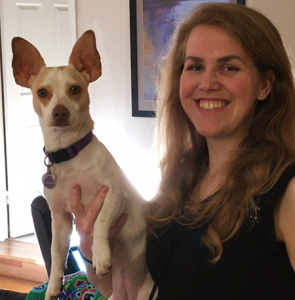“What kind of dog is that?”
In the year and a half since I adopted my lovable mutt, I have been asked the same question hundreds of times. I don’t blame them. My dog, Ellie, is pretty unusual looking. Between her big, batlike ears and long body, it’s hard to tell what breed she might be.

When I heard about the Wisdom Panel dog breed identification test, I was intrigued. In the test, common genetic variants in the dog genome are used as markers for specific breeds. These variant markers are not genes for certain traits but simply act as tracking devices for dog populations. In this panel, over 1,500 markers are tested, which have been validated through the analysis of 7,000 dogs of known breed origin. By comparing your dog’s genetic markers to the markers that are already known to belong to certain breeds, statistical algorithms can then determine what the most likely breed makeup of your dog is, up to the three generations back.
The test comes with two cotton swabs, which you stick in your dog’s mouth to grab a few cheek cells. Ellie did not enjoy this part of the test, and I couldn’t even bribe her with treats, since you don’t want any food to contaminate your DNA sample. After your swabs dry, you put them back in the test box, affix the included prepaid return label and send it off to the lab.
In my case, Wisdom Panel was able to make a good guess of what her breed might be. They said she was half Chihuahua-Shih Tzu cross, and half dachshund mix. If the panel cannot be certain what breed your dog is, you will often get a “mix” designation somewhere in your dog’s family tree. Even if you do see “mix,” your results will tell you what branch of the dog family your mutt might be from — whether it is the terriers, sighthounds or toy breeds. The test can also give you an estimate of your dog’s adult weight based on the weights of other dogs in its training set.

While I’ve mostly discussed mixed breeds, homozygosity mapping and principal component analysis (PCA) can show you if your purebred dog is similar to others in its breed. Homozygosity is the measure of how much of the dog’s DNA is identical on both chromosomes; this differs for each breed, since some are more inbred than others. Additionally, PCA can show that your dog is more similar to one or more breeds based on the genetic variance detected; this method is also used in human genetics to detect ethnicity.
While the Wisdom Panel website does not include the level of detail I wanted to know about the test, the methods the company used could accurately determine dog breed in some cases, like purebreds or “designer” mixes. However, I can’t say for sure that they would be able to detect the origin of highly mixed dogs given the small number of markers being tested. Would I recommend this test to a friend? Sure, but only with a “buyer beware.” For genetics enthusiasts, it’s a fun way to learn more about man’s best friend.
Related Content
- Sled Dogs Pull Their Weight in Rare Disease Genetics
Alaskan huskies affected by certain gene abnormalities may be a uniquely qualified model for the study and treatment of this rare human disease. Learn more. - The Friend Who Keeps You Young
Caring for a pet is great for both your physical and emotional health. A Johns Hopkins expert shares the proven connections—plus ways to benefit even if you’re not ready for the full-time responsibility of an animal. Read more. - Lab-Grown 3-D Intestine Regenerates Gut Lining In Dogs
Findings can lead to gut replacement therapy in people with intestinal deficiencies